Dr. Kevin Vaughn's Concord Grapes
Saturday, June 09, 2007
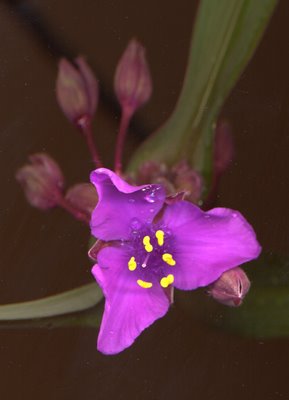
It was perhaps 6 or 7 years ago that I spotted a tall man with glasses at the Burrard door of the Vancouver Hotel. I went up to him and said, "How are you Dr. Vaughn? What are you doing in Vancouver?" He looked at me; thought about it and answered, "Hi, Alex I am here for botanical conference representing the US Department of Agriculture. My specialty is weeds."
In the late 70s and early 80s Kevin Vaughn was fascinated by hostas which are kind of the white mice of plants. Changes happen more quickly, they mutate with more frequency. Perhaps Vaughn saw in hostas a way of studying plants but in an accelerated way where more information could be obtained in less time. For his doctorate Vaughn wrote a treatise on the theory of how plants (and hostas in particular) variegate. He wrote these very important publications with K.G. Williams:
Chloroplast Mutants in Hosta
Genetics and Ultrastructure of a Dotted Leaf Pattern in Hosta.
An Ultrastructural Survey of Plastome Mutants of Hosta
From hosta Dr. Vaughn directed his research interest into Hemerocallis (daylillies).
Perhaps some 6 years ago I brought home some Tradescantia x andersoniana 'Concord Grape' for Rosemary. Tradescantias, named after John Tradescant, and English horticulturist and botanist have stems than when cut ooze a viscous secretion that hardens to form a silky web. This is why they are commonly called spiderworts.
Rosemary looked at my gift with doubt. Tradescantias remind me of the bird of prey space ships of Star Treck but Rosemary dislikes them because they flop over and look messy and the spent flowers (white in our garden)get rusty coloured.
Tradescantia x andersoniana 'Concord Grape' accurately named for the rich purple colour of their flowers surprised Rosemary by not flopping, blooming from late spring into fall and not only that, the spent blooms were tidy and beautiful.
Today I was surprised to discover that this plant is a Dr. Kevin Vaughn introduction. Some tradescantias are listed as weeds so perhaps in his research he decided to pass these on to us! Rosemary is grateful. And yet another plant in my garden has a human face behind it.
Through My Kitchen Door
Friday, June 08, 2007
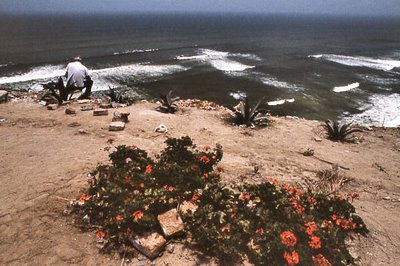  Since the 1950s I have eschewed air travel when Pan Am stewardesses handed out Juicy Fruit gum on Lockheed Super Constellations and metal detectors were used only for beachcombing. Now I prefer to get away in bed or by opening my kitchen door and venturing into my garden. Through association, just about every plant will take me elsewhere, often to another time and, more often than not, remind me of a person, too. I have been giving thought to the above as my eldest daughter Ale is moving to Lillooet to live in July. "Papi, " she told me, "I bought the property up there so that you and Mami can get away." The trip each way is 4 hours and on a weekend, whatever relaxation we would enjoy it would be contrasted with the agony and stress of having to drive back on a Sunday on the Freeway 1 or the more dangerous Sea to Sky Highway. Rosemary is most upset and we wonder how many times we will go to visit. By the time Ale understands our philosophy of travel we will be perhaps long gone. 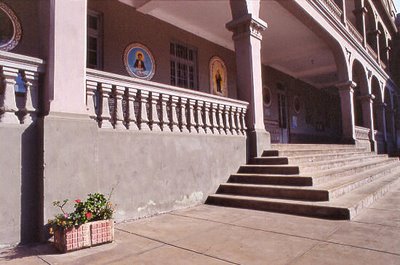 I remember as a child of 6 or 7 in Buenos Aires that I would go to our backyard " galpón" or shack were my father kept some old but very large wooden crates. In one I would place three bricks (gas pedal, brake, clutch), which I would lean on a thick board at my feet. Sitting on a smaller box in the middle of the crate and I would hold one of our dinner plates. It was my steering wheel. In seconds I was Juan Manuel Fangio, driving through the muddy roads of Argentina's interior. 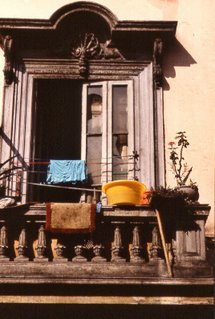 In the same way a plant propels me elsewhere. My Hosta 'Sieboldiana Elegans' whisks me to Japan. It was named for Philipp Franz Balthasar von Siebold, a German doctor who worked for Dutch traders on Dejima Island in Nagasaki harbour. Foreigners were not allowed on the mainland, so von Siebold would scour fodder sent to feed the livestock in hopes of finding unusual plants. That's where he saw his first hosta in 1823. 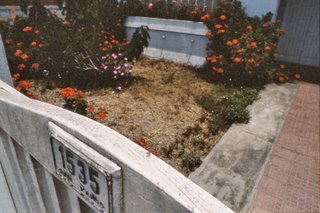 Another hosta, a bright yellow, green and white variegated Hosta 'Fortunei Albo Picta' beneath a white Camellia japonica , was named for Scottish plant hunter Robert Fortune. Because Camellia japonica is closely related to Camellia chinensis, the tea bush, it reminds me of Fortune's voyages in the Far East. In 1848 he traveled to China (dressed as a Chinese potentate and carried around in a litter) to spy on the cultivation of tea for the East India Company. Soon the British grew tea in India. 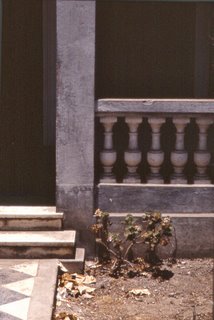 My Rosa 'Redouté'is an English Rose but it has ties to France. Redouté was the artist hired by Empress Josephine, an avid plant collector, to imortalize the roses in her famous garden at Malmaison. My thistles, Echinops ritro , and the taller thistle-like cardoon Cynara cardunculus , make me homesick for the Argentine pampa where I was raised. Charles Darwin describes the pampas in Voyage of the Beagle: There were immense beds of the thistle as well as of the cardoon: the whole country, indeed, may be called one great bed of these plants." 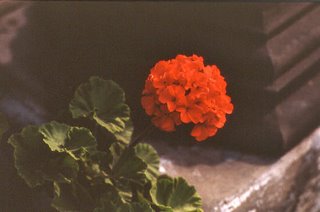 Sometimes I need only to travel to the kitchen, where a potted Pelargonium 'Vancouver Centennial' on the windowsill carries me away to Lima, Peru. In an interview with Peruvian novelist Mario Vargas Llosa in 1990, I asked him why his novels had frequent descriptions of potted pelargoniums (pelargoniums are commonly called geraniums but that is incorrect. While they are related, the true geranium, the crasnesbill geranium, is another plant altogether). Llosa explained that in 1499, Vasco da Gama brought the pelargonium from South Africa to Lisbon. It crossed to Exremadura in Spain. Then, whith Pizarro and Cortez, it sailed to the New World, finding a home in Lima's poor and sun-baked soil. "It thrives in adversity and neglect like our people," Llosa told me. 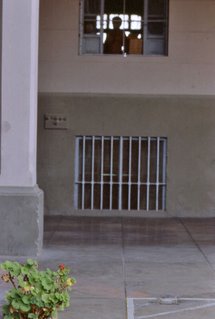 It is thanks to plant hunters, collectors and explorers that our gardens boast such botanical variety. We needn't suffer the vagaries of modern travel to experience the exotic world they explored. Now it is outside the kitchen door. 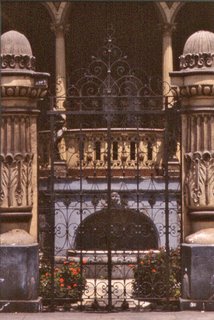 The photographs seen here are all pelargoniums (geraniums, if you will) in several areas of Lima, Peru. 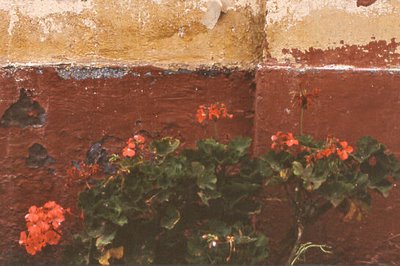
Cadbury Chocolate Eggs, Monk Testicles, Napoleon and Finger Bananas
Thursday, June 07, 2007
 One day, quite some time ago, I happened on a photograph of Napoleon's younger brother, Jerome, taken in 1852. And I realized then, with an amazement I have not been able to lessen since: "I am looking at eyes that looked at the Emperor." Sometimes I would mention this amazement, but since no one seemed to share it, nor even understand it (life consists of these little touches of solitude), I forgot about it. One day, quite some time ago, I happened on a photograph of Napoleon's younger brother, Jerome, taken in 1852. And I realized then, with an amazement I have not been able to lessen since: "I am looking at eyes that looked at the Emperor." Sometimes I would mention this amazement, but since no one seemed to share it, nor even understand it (life consists of these little touches of solitude), I forgot about it.Chapter 1 - Camera Lucida - Reflections on Photography Roland BarthesEver since I stared at Timothy O'Sullivan's photographs of American Civil War soldiers (and telling myself, "They were alive when these photographs were taken.") when I was around 9, I have been fascinated by photographs of long-dead people. I share and understand Roland Barthes's amazement. Looking out of my window as I write this I can see the almost white (with a deep yellow centre) single blooms of Rosa 'Dupontii'. My first impression makes me smile as they remind me of the Cadbury chocolate Easter eggs that Rosemary used to buy for Ale and Hilary (I would steal a few and eat them with pleasure) when they were little girls and we lived in Burnaby. A secondary thought is that I am looking at a healthy light green shrub (quite tall at 9 ft) decorated with perfect fried eggs. This vision does not quite agree with my memory that Dupontii has the scent of a ripe banana. That brings to mind the bananas, banana shaped chocolate covered soft candy that we Argentines love to eat when we go to the movies or the theatre. Those bananas are called bananas in Argentina even though in Mexico and in Spain bananas are plátanos. The white soft filling of the Argentine chocolates smell like Dupontii. 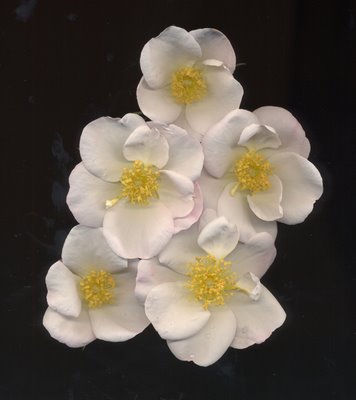 My grandmother had a fondness for what Americans call finger bananas. She called them plátanos dominicos and they were sometimes available in Mexico City. Abue would eat them with peanut butter and jam. In retrospect I would guess that they were called Dominican bananas after Dominican priests (the feared order of the Spanish Inquisition). The name was an irreverent opinion on the perceived size of their sexual organs. It was not only my grandmother who enjoyed the jelly filled (much bigger than the local but equivalent dougnut holes) suspiros de monja (nuns'sighs) but also called bolas de monje (monk's balls) I loved them, too, dunked in café con leche. Rosa 'Dupontii' at one time was considered a species rose so it was called Rosa dupontii. But recent research has indicated that this single rose (5 petals but sometimes with a couple more) is a cross between R. gallica and R. moschata. It was named for André Dupont, director of the Luxenburg Gardens in Paris. It is a safe guess that it was raised there, in about 1817. With further research I found out that Dupont was also a gardener at Empress Josephine's (Marie-Joseph-Rose-Tascher de la Pagerie) rose garden (over 250 varieties) at Malmaison. Alas I cannot make a direct connection between Napoleon and my Rosa 'Dupontii' as the rose came into existence two years after Waterloo (1815). But of course the non connection is a connection nonetheless. Dupontii not only makes me think of Cadbury chocolate eggs, fried eggs, bananas, small bananas but now also of the Emperor himself. After all if Josephine gazed upon both the Emperor and at Dupontii then the connection is there. 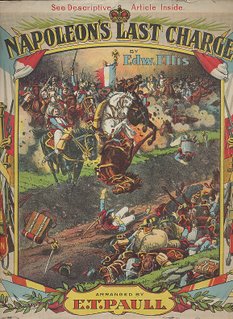 Rosemary came back last week from visiting her sister in New Dublin, Ontario. She brought back her old piano sheet music that she is going to have Rebecca play. One of the sheets caught my eye. NapoleonNapoleon in Egypt
Nueva Rosita, Coke & Abraham Darby Times 3
Wednesday, June 06, 2007
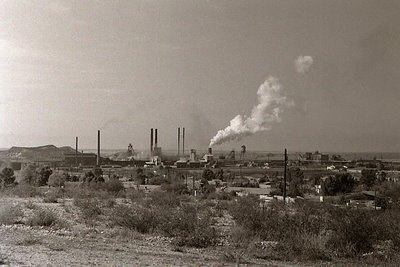 Coke is a solid carbonaceous material derived from destructive distillation of low-ash, low-sulfur bituminous coal. The volatile constituents of the coal, including water, coal-gas and coal-tar, are driven off by baking in an airless oven at temperatures as high as 1,000 degrees Celsius so that the fixed carbon and residual ash are fused together. Making coke, at least back in the mid 50s was a polluting endeavour but I never gave it much thought. In the mid 50s I lived with my mother in Nueva Rosita, Coahuila, a mining town where ASARCO (American Smelting & Refining Company) called the shots. I remember the first day I ever saw Nueva Rosita. We had landed, the day before in a DC-3 in a desolate airport (an airport because it had a dirt landing field that happened to have a shack with a revolving sock on the roof). This was Monclova, Coahuila which was the centre of the Mexican steel industry run principally by a company called Altos Hornos (high ovens). From Monclova we took a bus to Nueva Rosita. We arrived in the middle of the night but I remember seeing some lights and smoke that glowed in the dark cloudless sky. This was a high desert and I soon found out it rarely rained. When I woke up the next morning it was already around 38 degrees and I was bathed in sweat. I got up and looked out of the window. What I saw is what you see here even though I took this ancient Ektachrome and the b+w negative about three years later.  My mother explained that in Nueva Rosita they mined zinc and made coke. I never did ask what coke was but soon after I found out that coal was burned in an almost oxygen free oven and the coal was converted into a porous substance wich was used to make steel. I never did make the connection that our Nueva Rosita coke helped industrialize Mexico by contributing to the steel production of Monclova. It is only yesterday that I made the complete connection thanks to an English Rose, Abraham Darby, that has begun to bloom in my garden. This 1985 introduction by David Austin does not smell of myrrh like so many of my roses. It has an intense perfume of fruit and old roses. I should have obtained this lovely rose a long time ago. I finally did. I looked up Abraham Darby (1678-1717). It seems that by the end of the 17th century England was running out of forests to cut down to make the charcoal that was then used to smelt iron. It was around 1709 that Darby successfully used coke as fuel to smelt iron at his ironworks in Coalbrookdale in Shropshire. England had plenty of coal, from which coke was made.  Darby's process helped usher in England's industrial revolution. Darby's grandson, Abraham Darby III (1750 - 1791) constructed the world's first iron bridge, over the Severn river at Coalbrookdale, Shropshire in 1779. When I crossed the iron bridge in Shropshire I did not give it much thought nor did I stop at David Austin's rose nursery. This was 1987. I might have run into Rosa 'Abraham Darby' at Austin's nursery. But I didn't know much about roses then. I wasn't even interested in them. 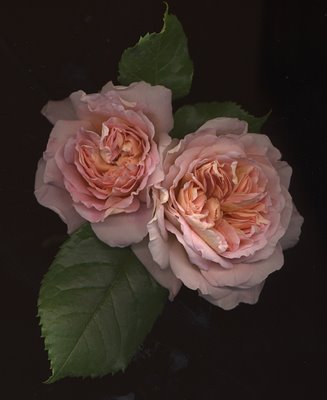 Last night when I brought in a couple of my Abraham Darby blooms, the intense perfume cleared my mind like Keen's Mustard and Nueva Rosita (small new rose), coke, iron, steel, the old iron bridge I had crossed back then, and David Austin's rose all came together and made a lot of sense. Pity my mother is not around. "You know mother, there is this rose and........"
Pristine, Cool, Crisp, Elegant (But Otherwise Ordinary) Hostas
Tuesday, June 05, 2007
 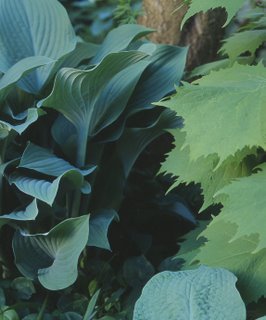 A few days ago in the late evening (8pm) I took some pictures of my emerging garden. It is in the waning days of May that hostas look their crisp best. The nicest feature of the hostas in these photographs is that most of them are ordinary hostas except for my prima donna Hosta 'June' that demands I photograph her whenever I look in her direction. She is always perfect and her perfection does not fade until September when most of my other hostas and perennials show the wear and tear of spent blooms, bug and slug damage and are ready to call it a year. Top left you see Hosta 'Krossa Regal' with Kirengeshoma palmata . Right is Hosta 'June' with Osmunda regalis (Royal Fern) to her right. Behind left is Hosta 'Gold Regal', not quite gold/yellow yet as the colouring happens in July. To June's right is an extremely ordinary and old hosta, so old that it is difficult to now get her in the local garden trade. 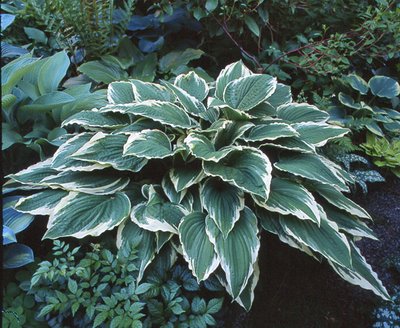 She is Hosta 'Antioch'. She measures five feet across and you can see more of her, left. Behind Osmunda regalis is the cinnamon fern, Osmunda cinnamomea. Sometimes it pays to play with a new camera that is not too familiar. The last picture seen here measures 4 inches across in its original size. The pictures taken by my German swivel lens panoramic, the Noblex 175 should be 7 inches across. I was ready to see Horst until I figured out that I had loaded the Noblex incorrectly. 
Cliff Robertson, Neil Armstrong & The Queen Of Denmark
Monday, June 04, 2007
 |
| Cliff Robertson,Whistler, British Columbia aka 80s - AlexWaterhouse-Hayward |
Many know exactly where they were and what they were doing the day that US President, John F. Kennedy was assasinated in Dallas. I know, too but I also know the coordinates for another important moment in our history. On July 20, 1969 at 10:17:42 (actually 9:17:42 as Mexico City did not have daylight saving time) when Neil Armstrong stepped on the moon, I shut off our TV in our Mexico City apartment and told my wife Rosemary we were going to the movies.
When I photographed actor Cliff Robertson in Whistler, BC, sometime in the late 80s I told him about my experience in seeing him play Charly in the 1969 Ralph Nelson film by the same name. I had read in 1964, Daniel Keyes's 1960 novel Flowers for Algernon (extended to novel form from his earlier novella) from which Charly's screen play was based on. Charly, the story of a retarded man who is chemically made intelligent but regresses back to his earlier state, while being lovingly cared for by Claire Bloom was a film I was not going to miss back in 1969. I had been married to Rosemary for a year but I still remembered one of my first girlfriends (1964) Judy Brown who to me looked like Claire Bloom. I simply saw all Claire Bloom films and still do. Besides I was a sucker for this sort of film as I then enjoyed Terence Stamp (who wakes from a coma after 30 years) in The Mind of Mr Soames. In this film Terence Stamp starts as a fully grown baby who very quickly learns to be an adult.
Because of the moon landing, Cine Polanco, where Rosemary and I saw Charly, was virtually empty. It made the tragic movie all that more poignant for us. I remember leaving the empty movie house completely drained with no memory of the event of the day that was unique to the human race. From that day on we could unequivocally think, "We (from the vantage point of the moon) are from there (pointing at the blue circle looming over the moon's horizon)!
There was one aspect of the film that would come to haunt me and almost offend me years later when around 1976 while watching TV in Vancouver I saw a commercial seeking money to research dyslexia. I was a dyslexic and I had never known. The Charly posters and the title of the film had that r reversed. It now almost offends me as much as Toys Я Us.
In 1970 we institutionalized my grandmdmother Lolita who progressively took baths and got ready for bed earlier and earlier during the day. One day she came back from seeing her son Tony (my Uncle Tony) in Egypt and she did not recognize who we were. This was my introduction to Alzheimer's. Since then I have known several close friends who have had to face this disease in their family.
On a purly objective look at Alzheimer's (ignoring the suffering of those who must live with family members who increasingly become violent) I find it an almost reversely symmetrical fading out of our existence that parallels our gradual fading into memory from birth. I remember being 6 but not before.
When my granddaughter Rebecca was 5 and we took her to Washington DC to the American Hosta Society National Convention, she played the a game of naming (in rapid succession) hostas connected to women with a woman who sported a convention tag on a DC Rapid Transit car. She fired off, Hosta 'Marilyn', Janet, Mildred Seaver, June and on. I was dazzled but I kept telling Rosemary, " If we were to die today, Rebecca would not remember us at all."
I have been noting with interest (Why did I not note this with my two daughters?) how Rebecca's memory seems to work. She has an excellent memory but the names of plants she knew well three years ago I must now reinforce as she has forgotten. Her mental process seems to mimic that terrible computer process by which sometimes when you write emails or in Word, and when you go back to correct mistakes, the insertion of the correction removes (gobbles up) the letters after it. A similar situation would be the running of a locomotive on a few set of tracks in which the forward path would be laid with tracks from ground covered that far.
Yesterday I went to Rebecca's and we mixed alfalfa meal with magnesium sulphate (epson salts) and watered her roses ( Rosa 'Mary Magdalene', Tuscany Superb, Mrs. Oakley Fisher, The Fairy and Popcorn ). We removed all the dead wood and leaves that had black spot. It was then that I was startled by a request.
"Papi, I really want Königin von Dänemark." Now Queen of Denmark is a brand new rose (an 1826 Alba) in my garden and it has yet to bloom. Twice in the last few weeks Rebecca has asked me to show her the rose bush as I had yet to find a spot for it. And when I did Rebecca did not know where it was. This rose has sparked her not quite fading interest in roses. I will have to buy her one.
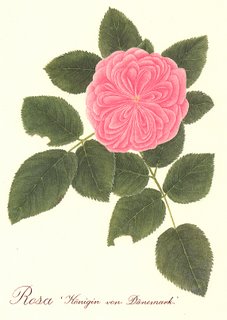
Charly, Mr. Soames, Rebecca: It is fascinating to watch the building up of memory so close at hand.
The Making Of A Snob - Part II
Sunday, June 03, 2007

To anybody who might be a faithful reader of this, and if you don't have a passing interest in roses, you may have to search for something else to while away the next few summer days. I am convinced that my relationship to roses helps me understand the world and the people I interact with. I am convinced that roses reveal to me my many flaws but at the same time they (the roses) gently offer corrections that just might make my relationship with others a bit better.
To continue on this subject of being a plant snob 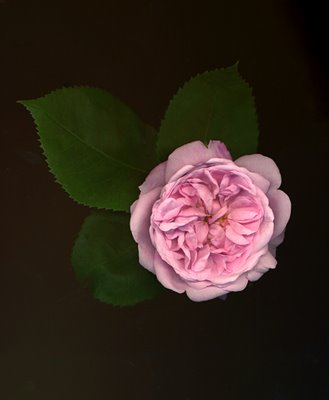 I must state that while I am dead serious there is also a bit of whimsical lightness in it. Take for example the three roses featured today. Of the first, the little five-petalled single, the species rose Rosa glauca Roger Phillips and Martyn Rix in their Random House Guide to Roses write:
Rosa glauca , Pourret ( R. rubrifolia Vill) A tall shrub up to 4 m with support but usually with arching branches and few thorns, easily recognized by its very grey or sometimes purplish leaves, and small deep pink flowers. Hips brownish red. Native of the mountains of Central Europe, from the Pyrenees and Alps eastwards to Poland, Romania and Albania, but not common. Introduced into cultivation in England before 1830, this rose has recently become excessively popular for its foliage, both in a garden setting and for use in flower arrangements. Beautiful specimen bushes grow on the terrace of Crathes Castle in Aberdeen.
Seen with Rosa glauca in my scan is David Austin's English Rose, Rosa 'St Swithun'. The highly scented (of myrrh) blooms are 4½ inches wide and my bush blooms most of the summer. The third rose is a classic rose, Rosa 'Fantin Latour'of which little is known. Peter Beales writes in his Classic Roses :
A superb mystery rose with records conspicuously absent. The soft delicate pink flowers and their form place them here (Centifolias[Provence Roses, Cabbage Roses] -Forms and Hybrids), although its foliage is smoother, darker green and more rounded than is typical. Its shoots too are less thorny. I find the all-pervading perfume rather more Alba-like than Centifolia. One theory of its origin suggests that it was once used as an understock, but since it does not root readily from cuttings, at least for me, I think this unlikely.
From the point of beeing a practical gardener one would say that the best rose here is Rosa 'St Swithun' as it has very large, beautiful and extremely fragrant blooms which occur from June to fall. Rosa glauca blooms only once and the flowers are only lightly scented and quite small. Fantin Latour flowers are 3 inches wide, they are scented but they appear only once in early June and that's it for the season.
Some snobs (and I know a few of these) keep their Rosa glaucas pruned severely (they get almost no flowers) but the foliage of these specimen plants is fresh and the leaves develop that prized and snobbish glaucous green. I would like to add that that Rosa glauca immediately develops hips (right after the blooms) that are the colour of Hershey milk chocolate!
The scans you see here are all from flowers I cut today from plants in my garden. This snob has chosen to have all three for different reasons. I have been rewarded in my choice democracy by discovering (after a 7 year wait) that Rosa 'Fantin Latour' when allowed to grow to about 7 ft will become extremely shade tolerant. In my garden where I have a heavy tree canopy this is a definite plus. And this is true even if a true plant snob would point out that Fantin Latour's leaves are a bit too big in proportion to the size of bloom.
Rosa glauca appeals to my Rosemary who may be more of a snob (or at least in the direction of plants that may have blue in them and are not immediately showy) than I am. We have two very large specimens which never show any disease.
Now St. Swithun is special for me because it was the last rose Rosemary ever showed a keen interest in. She lost this interest, outwardly at least, as soon as I became enamoured with roses. Some 7 years back Rosemary spotted St. Swithun at the VanDusen Garden Show and she told me she had to have it. It was a display plant at a nursery booth so she went early on the last day and put a hold on it. We brought him home and it rained for a week. It rained so much that it made the news.
I investigated the story behind St. Swithun and this is what I found out. St. Swithun is apparently the saint to blame for rainy summers. It is said that if it rains on his special day, 15 July, it will then rain for forty days after that.
It all began when he was made Bishop of Winchester in 852 by King Ethelwulf of Wessex. Winchester was the capital of Wessex, and during the 10 years Swithun was there, Wessex became the most important kingdom of England.
During his life, instead of washing out people's summer holidays, and damping down their spirits, Swithun seems to have done a lot of good. He was famous for his charitable gifts and for his energy in getting churches built. When he was dying in 862, he asked that he be buried in the cemetery of the Old Minster, just outside the west door.
If he had been left there in peace, who knows how many rainy summers the English may have been spared over the last 1000 years. But, no, it was decided to move Swithun. By now, the 960s, Winchester had become the first monastic cathedral chapter in England, and the newly installed monks wanted Swithun in the cathedral with them. So finally, on 15 July 971, his bones were dug up and Swithun was translated into the cathedral.
That same day many people claimed to have had miraculous cures. Certainly everyone got wet, for the heavens opened. The unusually heavy rain that day, and on the days following, was attributed to the power of St Swithun.
Swithun was moved again in 1093, into the new Winchester cathedral. His shrine was a popular place of pilgrimage throughout the middle ages. The shrine was destroyed during the Reformation, and restored in 1962.
It would seem that being able to have all three roses in my garden would represent a botanical version of learning to live with one's friends. If being a plant snob creates this situation then we should all grow Rosa glauca and when visitors come to your garden, like Rosemary you would say, "The flowers are insignificant but isn't the foliage lovely?"
The Making of a Snob
|
































